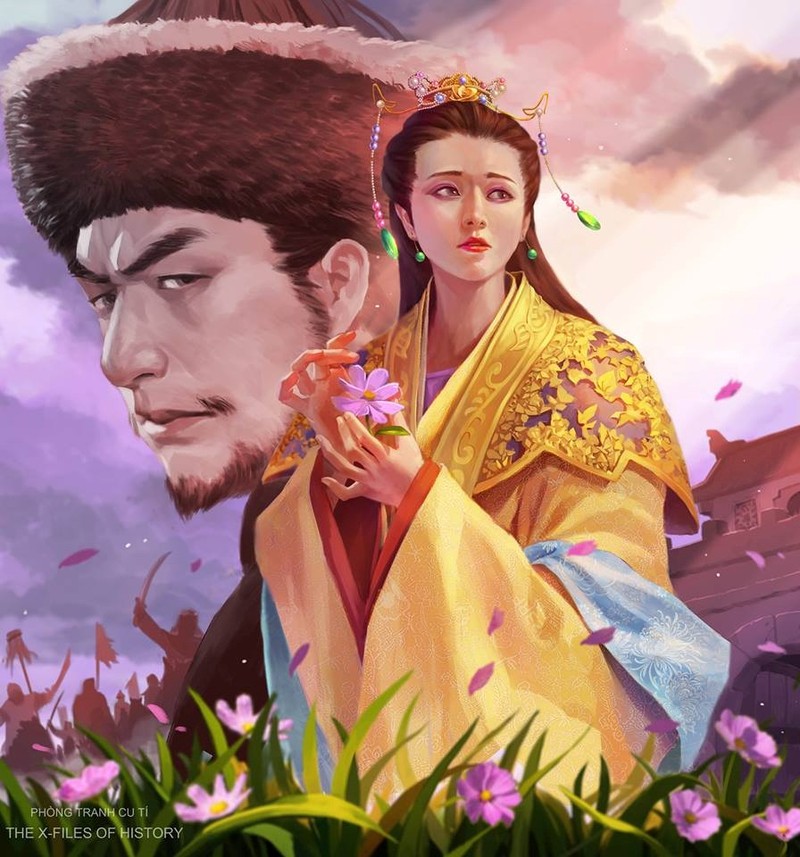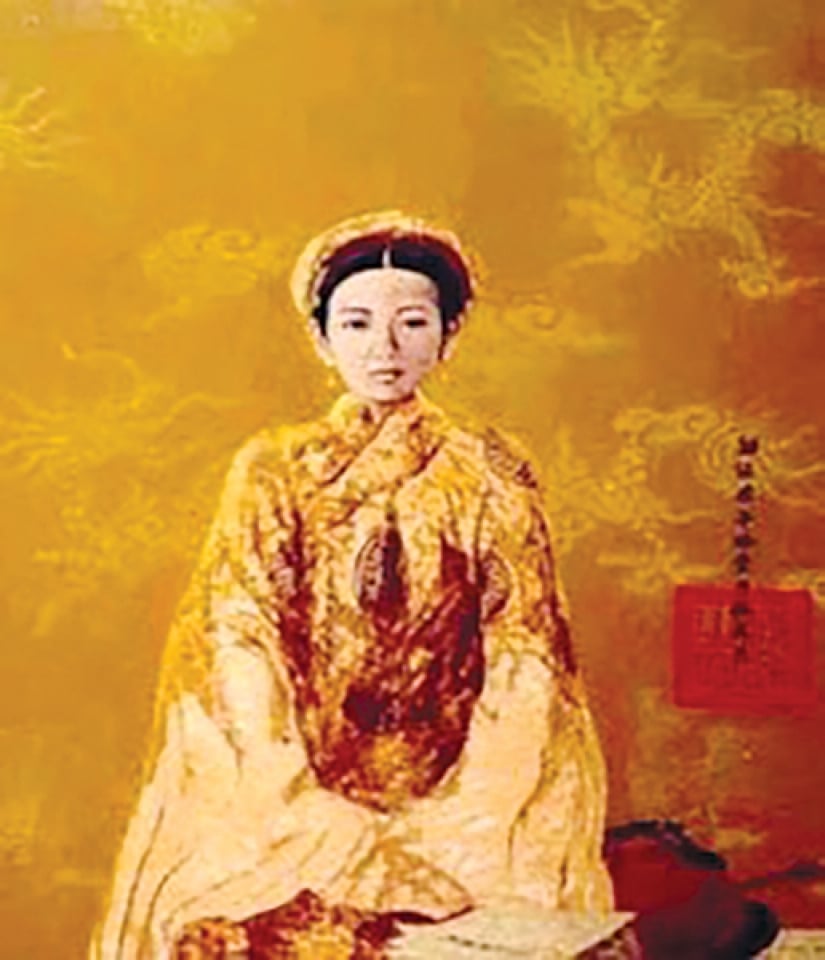Princess An Tu

With scarce and rare information recorded in the Complete Annals of the Đại Việt, Princess An Tu’s exact birth and death dates are unknown. She was the daughter of an unnamed concubine and the youngest daughter of King Trần Thái Tông, the sister of King Trần Thánh Tông, and the younger sister of King Trần Nhân Tông. In historical records, Princess An Tu is referred to as Thánh Tông Quý Muội (Thánh Tông’s Beloved Younger Sister) or Hoàng Quý Muội.
According to the “Dictionary of Vietnamese Historical Figures,” in the war against the Mongol invaders led by Trần Quốc Tuấn, Princess An Tu played a significant role in the victory and made great sacrifices for the country. Out of a sense of duty, An Tu had to shoulder a historical mission. The Vietnamese chronicles briefly mention her, such as Ngô Sĩ Liên’s “Complete Annals of the Đại Việt,” which states: “In the second month of the year (Ất Dậu), an envoy was sent to deliver Princess Thiên Tư (who was actually Princess An Tu) to Thoát Hoan for seeking help for the country.”
Princess Huyền Trân

Princess Huyền Trân was born in 1287. She was the daughter of King Trần Nhân Tông and the younger sister of King Trần Anh Tông. In 1306, Huyền Trân was married to King Chiêm Thành (Champa) named Chế Mân in exchange for two provinces, Ô and Lý (from Hải Vân Pass, Thừa Thiên Province to the northern Quảng Trị Province of today). She is still remembered for her great sacrifice for the nation.
After the death of King Chế Mân, the Trần dynasty sent General Trần Khắc Chung to visit Huyền Trân and plan her return to the country. The homecoming journey lasted for over a year, during which the two developed feelings for each other. Upon arriving in Thăng Long, Huyền Trân became a Buddhist nun and took the Dharma name Hương Tràng, establishing a hermitage for spiritual practice. The hermitage later became Phật Điện Quảng Nghiêm Tự (Nam Định).
Princess Ngọc Hân

Princess Ngọc Hân, also known as the Northern Palace Queen, is a famous figure in Vietnamese history. She is remembered for her beautiful love story with King Quang Trung.
Princess Ngọc Hân was born on April 27, 1770. According to historical records, she was the 9th or 21st daughter of Emperor Lê Hiển Tông. Her mother was Nguyễn Thị Huyền, a native of Phù Ninh village in Từ Sơn, Bắc Ninh province.
Thanks to the matchmaking of General Bắc Hà, who was Nguyễn Hữu Chỉnh, Lê Ngọc Hân married Nguyễn Huệ when she was only 16 years old. At that time, Nguyễn Huệ was 33 years old and already had a wife, Phạm Thị Liên. In the second Chiêu Thống year, equivalent to 1788, Nguyễn Huệ ascended to the throne as Emperor Quang Trung and appointed Huyền Trân as Hữu cung Hoàng hậu (Queen Consort). In 1789, Nguyễn Huệ raised her to the rank of Bắc cung Hoàng hậu (Northern Palace Queen). Huyền Trân gave birth to two children: Princess Nguyễn Thị Ngọc Bảo and Prince Nguyễn Quang Đức.
Princess Ngọc Hân was regarded by the people as a flawless, beautiful, intelligent woman with diverse talents. After the sudden death of King Quang Trung in 1792, she and her children lived a simple life in Kim Tiền Pagoda. On December 4, 1799, she passed away at the age of 29. Shortly after, both of her children also passed away.
Scholar Nguyễn Thị Lộ
Nguyễn Thị Lộ, from Thái Bình province, was the lover of Nguyễn Trãi. She was also a central figure in the famous Lệ Chi Viên case, which led to the mysterious death of Emperor Lê Thái Tông and brought about the tragic demise of Nguyễn Trãi and three generations of his family.
She was an outstanding educator and was responsible for teaching palace maidens and concubines about the royal ceremonies and protocols during the Lê dynasty. There are very few written records about her, but in the Complete Annals of the Đại Việt, there are a few brief lines mentioning her, as it is related to the death of Emperor Lê Thánh Tông: “Previously, the king favored Ty’s wife, Nguyễn Thị Lộ, a beautiful and talented woman. He called her into the palace to teach the ceremonial rites…”.
Nguyễn Thị Lộ was known for her literary skills. Her romantic relationship with Nguyễn Trãi began with poetry. One day, as Nguyễn Trãi was returning from paying respects, he encountered a beautiful straw mat vendor and composed a teasing poem. To his surprise, the mat vendor responded with her own verse. Thus, their fateful encounter sparked a deep connection, and the heroic man and demure woman shared an eternal bond. Nguyễn Thị Lộ became Nguyễn Trãi’s confidante and companion, sharing both joys and sorrows in life.
After becoming Nguyễn Trãi’s concubine, Nguyễn Thị Lộ’s talent became widely known in the capital. Later, she was appointed by Emperor Lê Thái Tông (1434-1439) to the position of Lễ nghi học sĩ, responsible for teaching palace maidens and concubines the royal etiquettes and customs.
Queen Nguyên Phi Ỷ Lan

Nguyên Phi Ỷ Lan, whose real name was Lê Thị Yến, was the wife of King Lý Thánh Tông and made significant contributions to the Lý dynasty. She was born into a poor family in Hưng Yên province after the deaths of her parents and grew up under the care of her aunt. She earned a living by growing mulberries and raising silkworms.
When the king’s procession passed through her village, the villagers gathered to welcome the king, but Ỷ Lan remained leaning against a lan-oïl tree, refusing to greet the king. An old oil vendor passing by saw the unusual cloud covering her, as if shielding her from the sun, and asked, “Why don’t you go see the king?” Ỷ Lan replied, “As a poor girl, how can I be worthy of seeing the king!”
Upon hearing this, King Lý Thánh Tông sent an envoy to inquire about her. The king asked, “Why does everyone in the realm come to see the festivities and me, but you continue to pick mulberries there?” She respectfully replied, “My aunt asked me to pick mulberries; she didn’t ask me to see the king. Therefore, I must follow her instructions.”
The king was astonished and said, “She is a person of virtue, perhaps unparalleled in the realm.” He then ordered Ỷ Lan to be brought into the palace and bestowed upon her his love. She was given the title of Ỷ Lan phu nhân (Consort Ỷ Lan).
Despite being a young woman, Nguyên phi Ỷ Lan possessed great governance and administrative skills. She twice assumed political power alongside the court officials and King Lý to maintain the nation.
The first instance was recorded in the Complete Annals of the Đại Việt, which states that in the spring of 1069, the king went to war against Chiêm Thành. In this campaign, the king was not initially successful, but the news that Nguyên phi was helping with internal affairs brought joy to the people’s hearts. Amidst tranquility and the prevalence of Buddhism, the people revered her as the goddess of mercy (Quan Âm), and the king remarked, “Nguyên phi accomplishes what men cannot!” After saying this, he returned to the battlefield and achieved victory, capturing Chế Củ and 50,000 people.
The second instance was when the king passed away at the Hội Tiên Palace. At that time, Crown Prince Càn Đức, who was only 7 years old, ascended the throne in front of the royal funeral procession. His biological mother Ỷ Lan was made the Hoàng Thái Phi (Queen Consort), and his birth mother, Thượng Dương Dương Thị, was made the Hoàng Thái Hậu (Empress). They assumed political power together, listening to court affairs with the assistance of Thái Sư Lý Đạo Thành.
Vietnamese Princess: Embarking on a Spiritual Journey after a Year as Queen, Revered as the Divine Mother by the People
Vietnam’s history is filled with talented and virtuous princesses who have made significant contributions to the country. Among them, Princess Huyen Tran, the youngest daughter of King Tran Nhan Tong, stands out with her remarkable life full of ups and downs and mythical tales.


































